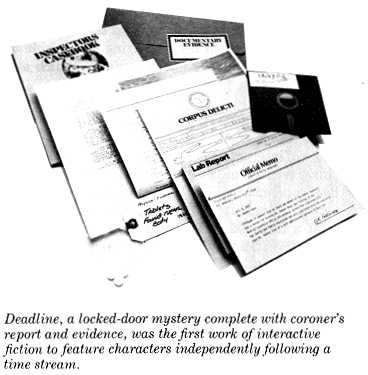FICTION AND THE
 FUTURE OF
FUTURE OFTHE NOVEL
By Michael Berlyn and Marc Blank
Michael Berlyn is a science fiction writer and game designer for Infocom. Marc Blank is vice-president of Infocom product development.
The novel of the future is here. Exclusively on personal computers.
If you've ever wondered what it would be like to be an adventurer-not just someone you read about, but someone you can truly become-there are worlds waiting to unfold their mysteries. Fictional worlds, where you are no longer limited to reading about characters. Worlds of words, where you participate far beyond turning a page to see what happens next.
Picture this: You slip a floppy disk into your home computer and are greeted by a brief text describing who and where you are. When you're done reading, you are transported to that place where anything you want to have happen can happen-in a fictional universe with which you can interact.
Say you find yourself in a room with a balcony. You might type in a simple instruction like Go TO THE BALCONY and the story will go to its next setting. If you encounter another character in the story or find some object that may be critical to your progress, you might type something like ASK MR. ROBNER ABOUT MRS. ROBNER and the story will respond to your commands. The computer tells you what happens as a result, and waits for you to decide what you'd like to do next.
The Interactive Reader
Interactive fiction is similar to ordinary novels in only two ways: both communicate with you through prose and both are fiction. But that's where the similarity ends. The experience of reading a book or watching a movie, play or television program is passive. Interactive fiction is never passive.
The concept of "story" or "plot" in interactive fiction differs from that in novels or screenplays. You don't watch or read about someone doing something. You do it yourself. The "story" is not waiting for you to walk through it; instead it grows dynamically with each decision you make.
Interactive fiction could only be written on and experienced through a computer. Primitive distant relations exist in book form-"decision novels"-but their relationship to true interactive fiction is as close as a calculator's might be to a computer. Reading a decision novel is much like walking along a path: when you come to a fork in the path, you must decide on the left path or the right path. You cannot leave the path. Decision books look a lot more like novels than interactive fiction. They are cleverly woven stories that overlap at certain points and they are a far cry from being interactive. They do allow you a choice, a "decision," but what happens if you want to do something that is not one of the preconceived choices?
Only a computer can create a world where, at each turn, you can make thousands of decisions. Decision books pale in comparison. The computer produces interactions between yourself (as the main character in the story), other characters, objects and changing situations. Your current location, whether it's a small shack, a tent in the desert or a magical castle, is a small part of the computer-mediated environment. You can move around this world and explore. Each new place offers new things to be done.
Characters other than your own can also walk around through this environment. They may have their own goals and can follow their own machinations. They can walk around independently (if you are not in a location when a character walks through it, you might not even know of his existence). If a character walks through a room in which you are standing, you can choose to ignore him or interact with him.
Objects sitting on tables-even the very tables themselves-can be manipulated by your character if you so direct. Want your character to look under the table? Simple. Just type LOOK UNDER THE TABLE.
Writers of interactive fiction create a small universe in which there is consistency, even to the smallest detail. A simple example would be a container. Let's say you're in the wilderness and you're thirsty. There's a stream nearby, so you go over and take a drink. But what happens in a few hours, when you've wandered away from the stream and get thirsty again? You can't carry water around in your hands. In fact, the computer might object: YOU TRY TO PICK UP THE WATER, BUT IT LEAKS THROUGH YOUR FINGERS. So you need something in which to keep the water. You might run across an old tin can sitting by the side of the road. You might also find a canteen. Which one should you use?

The Adventure Begins
The roots of interactive fiction can be traced to Adventure, first
written as an experiment on a mainframe and later a popular game when
translated for personal computers. Adventure allowed players to type in
two words at a time-almost always a verb and a noun. This sentence
structure severely limited interaction. The parser, the part of the
computer program that was trying to understand what was being typed in,
was a very primitive beast; it was looking for a verb/noun pair-FILL
CANTEEN-and that was the only thing it accepted. The limitation of
interacting with a complex world by using simple commands became a
problem.
Many people attempted to imitate the original
Adventure. Indeed, so many programmers were fascinated by this type of
interaction that they were responsible for the birth of an entire genre
of software known as adventure games, in which the player communicates
with the computer by typing in simple commands; the computer then
responds with whatever results seem appropriate.

How are interactive fiction and the old adventure
games different? After all, they are both interactive-the computer does
respond to your input-and they both expect your input to be in the form
of a sentence. One difference is that in an adventure-type game you
might type OPEN TRUNK, while in interactive fiction you might instruct
the program: BREAK THE LOCK WITH THE ROCK, THEN OPEN UP THE TRUNK.
Zork was the first game to include a sophisticated
full-sentence parser that allowed for fairly complex input. It also
introduced the concept of having things happen at a preset time,
whether the player liked it or not. Unfortunately, Zork did little with
these concepts, but its progeny have done wonders in making these games
into interactive fiction.
Of Time and Words
Interactive fiction goes beyond adventure games with two important
elements: a time stream and autonomous characters. When you read a
story or a novel, a sense of time is created by the author. It's as if
you are plunged into a moving stream and carried along by the current.
There is a feeling of moving inexorably toward an ending, of situations
unfolding as a direct result of the passage of time. In some fiction
pieces the invisible clock ticks slowly, while in others the clock
seems to speed along. While the character you are reading about is out
shopping at the store, his house could be robbed. Or the store could be
robbed while he was there, making him an eyewitness.
Without this sense of time, of movement, a piece of
prose would not be fiction-it would simply be prose. There would be
little if any driving force to get us to turn the pages and finish
reading. The same holds true in interactive fiction. This driving
force, this time stream that carries us along, is in one sense the
story's plot.
Without a sense of time, the game may be
interactive, but it is certainly not fiction. In some interactive
fiction, as day gradually becomes night, the character you portray can
experience hunger, thirst or fatigue. In some cases looking under a bed
takes less time than does walking across a large wooded area. The time
stream becomes more obvious and more significant when autonomous
characters are introduced. If you are the main character in a mystery
story, then who are the suspects? Aren't they characters, too? If you
ask an upsetting question, shouldn't they react accordingly? If one of
them realizes you're following him, shouldn't he change his course of
action?
Once secondary characters in the stories stood up
and walked around the environment, something strange happened to the
program writers. They realized they had something more than just a
"nice feature" for another game: what they were working on was, at
least on one level, much more than a game.
Picture this: You're stranded on a desert island,
doing your best to survive. You decide to explore the island
completely, making a map of virtually every square inch of the place.
You encounter obstaclescliffs to be scaled, lagoons to be crossed-and
you fashion makeshift ropes and fish hooks. The problems are all
solvable.
When characters who move about the environment were
introduced in interactive fiction, people stopped playing the programs
as games or puzzles and started feeling and experiencing them as
stories. Deadline, the breakthrough game that offered this feature, is
still one of the most popular pieces of interactive fiction software.
And there have been others, each a little more intelligent in how the
person playing the protagonist interacts with the rest of the
characters in the story. The complexity of interaction continues to
deepen, but we will eventually reach a point beyond which more complete
interactions would be impossible with the current generation of
personal computers.
Parser technology, teaching the computer to
understand what the player types at the keyboard, is rapidly improving.
At present, to elicit information from
a character, a player might type: MRS. ROBNER, TELL ME ABOUT GEORGE. In
the near future, the same player should be able to type more complex
sentences: MRS. ROBNER, TELL ME IF GEORGE LIKES TO EAT PEACHES.
The medium of interactive fiction is still in its
infancy, but it is growing by leaps and bounds. There are mysteries,
juveniles, science fiction, adventures and fantasies. Other genres may
follow, but for now there's something for everyone who likes to read a
good book. And for people who like to be in a good book, the future is
just starting.
| HOW A COMPUTER RESPONDS TO YOUR WORDS One of the strongest experiences of a good adventure game or interactive fiction is the feeling you get when the computer answers your words. You could swear you're not just typing commands at your keyboard-that in fact you're talking to someone inside your computer. Your first experience with even the most sophisticated piece of interactive fiction will also make you aware of its limitations. Many people are amazed that a sentence of any sort can be understood; others are appalled that a sentence like "Where were you after you left the drugstore the other night?" could cause a problem. After all, it is a simple question. Consider the problem from the computer's point of view. As you type, the keystrokes are recognized and remembered. When you hit the RETURN key, the program receives a sequence of characters that correspond to the keys you've typed. But there is no meaning in the characters themselves. Meaning has to reside in the way they are combined to form words and sentences. The extraction of meaning from written language requires intelligence. Unfortunately, the computer has none. The best we can do is teach it some rules to make it seem intelligent. Teaching Grammar We can start by teaching the computer that words are usually separated by the "space" character. Using this rule, the sentence "Take the house" can be broken into three words. This may seem simplistic, but it's not. When you look at the sentence, you instinctively see three words. The computer has no such instinct and "sees" only apparently arbitrary patterns. Breaking the sentence into words is simple. Knowing that "Take the house" consists of three words is useful, but it says nothing about what the sentence means unless you already know English. The computer doesn't. Let's try to teach the computer English by thinking through some questions about the words we've found. Are the words English words? We can solve this problem the way Noah Webster did, by creating a dictionary in which we list all the words in the language and some information about each. We might, for example, list in the dictionary that "take" is a verb form, "the" is an article and "house" is a noun. But this isn't enough to understand language. Do the words form a sentence? Here we come to the next problem: grammar. Do the words "Take the house" make a legal (i.e., grammatical) sentence? We might list all the legal sentence forms: For example, verb/noun, verb/article/noun and verb/preposition/noun are each legal structures for a sentence. Assuming we have created such a list, we can tell that our example is legal in structure. But is the sentence reasonable? Using our list of possible sentence structures, we would find that "Take with house" is legal. On the other hand, it leaves something to be desired semantically. Therefore, we need some rules for indicating which sentences are legal from the standpoint of surface meaning. The simplest approach would be to make a list of forms that are appropriate for a given verb. In our example, sentences beginning with the verb "Take" might include "Take something" and "Take something out of something." Assuming we have compiled the comprehensive list, we can tell that "Take with house" is not reasonable and that "Take the house" is. Playing House Now we come to the question we started with. How does the computer understand what we mean when we type something? The answer is much more complicated than merely recognizing that the words form a reasonable sentence. Before we can teach the computer to answer the important question about "Take the house," it must be taught something about the concept of "take." Can everything be taken? If not, what are the properties of things that can be taken? Who (or what) can take things, and how many of them? All of this must be taught to the computer. Then we must teach the concept of "house." What constitutes a house? What properties do houses have in common? Can they be taken? Can they be used as wood for bonfires? In the context of a particular piece of interactive fiction, we will have to be more specific. Are we referring to a particular house? Is this particular house different from houses in general? Look how far we've come just to understand one short sentence. The programming involved in the first few steps (this act of uncovering the structure of a sentence is called parsing) is difficult enough, but the real stumbling block is extracting the meaning of the sentence. Writing sophisticated interactive fiction is an act of creation. To be successful, the author must create not only things, but also the rules that act upon them-the laws of nature for the world he has created. These laws need not be the laws of our world-the story may take place in another galaxy or alternate reality. What is important, though, is the sense of completeness and consistency found in this world. Everyone writing interactive fiction talks about his parser. Many writers claim their parser understands full sentences, but most parsers understand little more than verb/noun pairing. They look for a few key words and ignore everything else in the sentence. Besides, talking about one's parser is actually beside the point. Real intelligence on the computer's part-understanding what you mean-requires knowledge of how the created world works. The parser is not the be-all and end-all of interactive fiction. Understanding. The ability to "get what you mean." The parser is merely a tool in the hands of the creative human author. No ordinary author, but one capable of imagining and planning responses to the innumerable entries only humans are capable of, and managing to tell a story. A good parser won't guarantee a first-rate piece of interactive fiction. Only an author's imagination can do that. MICHAEL BERLYN AND MARC BLANK |
Return to Table of Contents | Previous Article | Next Article

